|
|
|||||||
 |
|
|
Thread Tools | Display Modes |
|
|
|
#1
|
||||
|
||||
|
This has been knocking around in my head for some time now. I've been wanting to lead a discussion about the players who, for one reason or another, have been overlooked by the Baseball Writers, and even the Veterans Committee. Players that we feel merit further consideration for the Hall of Fame. Only this discussion is going to be different than the other ones that have been going on since the first Hall of Fame class was voted into Cooperstown in 1936. It's going to be different than the Hall of Fame debate that just popped up on the pre-war main forum earlier today. In this discussion, we are going to remove emotion, and team loyalty, from the equation. There will be no hyperbole. This discussion will revolve around facts. Statistics. Comparisons of the players we are considering to the others who were in the Major Leagues at the same time. We are, in essence, going to be creating our own arguments for these players. We are going to look at it as if we were making the case for these players to the BBWAA, or the Veterans Committee themselves. Gentlemen, we are going to be advocates for some of the greats of the game who have fallen in between the cracks.
In mid August, I received an e-mail from Ken (earlywynnfan) asking if I could do an analysis of some players, and their Hall of Fame chances. He wanted to look at Carl Mays, Minnie Minoso and Omar Vizquel. I think all three men warrant consideration. Vizquel has not yet met the 5 year waiting period, as he last played in 2012. So it will be interesting to see how he does in the actual BBWAA vote, and how that vote compares to what we find here. I am also going to ask you all to come up with suggestions of players you feel should be looked at again. Keep in mind that the Hall of Fame exists to recognize the true greats of the game, so these players should have been exceptional. The first player I will be looking at is one of the worst hitters in the history of Major League Baseball. That player is Mark Belanger. Belanger is, in my opinion, one of the finest defensive baseball player in the game's history.
__________________
Building these sets: T206, 1953 Bowman Color, 1975 Topps. Great transactions with: piedmont150, Cardboard Junkie, z28jd, t206blogcom, tinkertoeverstochance, trobba, Texxxx, marcdelpercio, t206hound, zachs, tolstoi, IronHorse 2130, AndyG09, BBT206, jtschantz, lug-nut, leaflover, Abravefan11, mpemulis, btcarfagno, BlueSky, and Frankbmd. Last edited by the 'stache; 09-16-2014 at 02:10 AM. Reason: edited language to reflect true purpose of the discussion |
|
#2
|
||||
|
||||
|
Mark Belanger, shortstop
Mark Henry Belanger (The Blade) Baltimore Orioles (1965-1981) Los Angeles Dodgers (1982)  Career stats  Leading off this discussion with perhaps the very worst hitter of the modern era as my choice for most deserving of Cooperstown induction may seem strange. But make no mistake about it. Mark Belanger is worthy of the Hall of Fame. That he is not there is a monumental oversight by the Baseball Writers and the Veterans Committee. 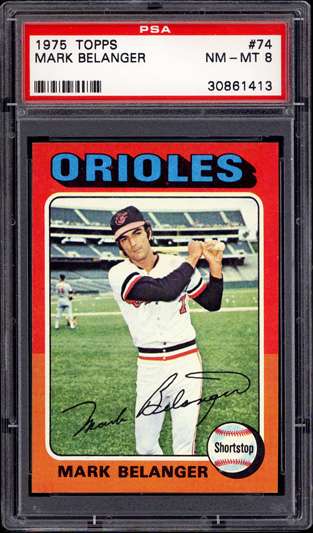 My 1975 Topps Mark Belanger. I've long felt that the Baseball Hall of Fame was offense biased. If you were a career .330 hitter with 2,500 hits and a few MVPs, you were in. For the longest time, if a player reached the 3,000 hit plateau, or hit 500 home runs, they were virtually assured that the Baseball Writers were going to elect them after the mandatory 5 year waiting period had been met. But then again, offense has always been easier to study than defense. The number of home runs, or runs batted in a hitter tallied in one season was easy to track. Defense has always been harder to measure. You might know a great play when you see it, but in the boxscore, it just showed up as an out. Brooks Robinson makes a spectacular play at third on a ball slicing down the line in the 1970 World Series against the Cincinnati Reds, and throws the ball all the way across the field to the first baseman for the out. One of the truly iconic plays in the history of baseball. The box score shows it as a 5-3 groundout. You could say "wow", but there was really no way to quantify how good he was. The statistics used to measure defense were woefully inadequate. Assists, double plays, fielding percentage. If you didn't make any mistakes, you could end the season with a 1.000 fielding percentage. Fielding percentage actually seemed to penalize the best fielders. Some balls could not be caught. Some the truly great shortstops, or second basemen, tried to get, but could not turn into an out. Those might have been ruled an error by the official scorekeeper. Nevermind that the ball was a full three steps to the right of the shortstop, and mere mortal men would not have even gotten to the ball. But the great defenders were all too often overlooked. Some of the great defenders were also great hitters. Clemente won batting titles. In his prime, Brooks Robinson hit enough to win an MVP. Curt Flood, in his prime, was a .300 hitter with a little power, and a little speed. But some of the very best fielders were not great hitters, and so they were overlooked when it came time to hand out awards. They were forgotten when it came time to vote for the Hall of Fame. Mark Belanger was a bad hitter. A really bad hitter. How bad? Of all the hitters with 5,000 or more at bats in the modern era (1920 to today), Belanger had the lowest OPS of all. OPS, of course, combines OBP (on base percentage) with SLG (slugging percentage), or power. Nobody did both getting on base and hitting for power worse than Mark Belanger.  Belanger appeared on the 1988 Hall of Fame ballot, and only received 3.7% of the vote. He did not meet the minimum threshold to stay on the ballot (5%). So, that was it. In 1988, Sabermetrics did not exist. The members of the BBWAA (Baseball Writers of America) only had Belanger's putrid offensive numbers, and the most basic of defensive metrics to go off of. And they knew he had 8 Gold Gloves. Well, Brooks Robinson, who was to his right, had sixteen Gold Gloves, so clearly, Belanger benefitted from Robinson's presence. Since he couldn't hit, and since 8 Gold Gloves was good, but not really great, especially considering who played alongside of him, Belanger's Hall of Fame eligibility was basically discarded. What if I were to tell you that in the history of baseball, Mark Belanger had the second highest dWAR of all-time? dWAR is Defensive Wins Above Replacement. Click the link if you need an explanation of what WAR is, and how it's calculated. The only player with a higher dWAR than Mark Belanger is Ozzie Smith. More on that in a minute. In the history of Major League Baseball (modern era 1920 to present), there have only been 25 players to compile a career dWAR of 20 or higher. The list that follows shows the truly elite defensive players in the game's history. 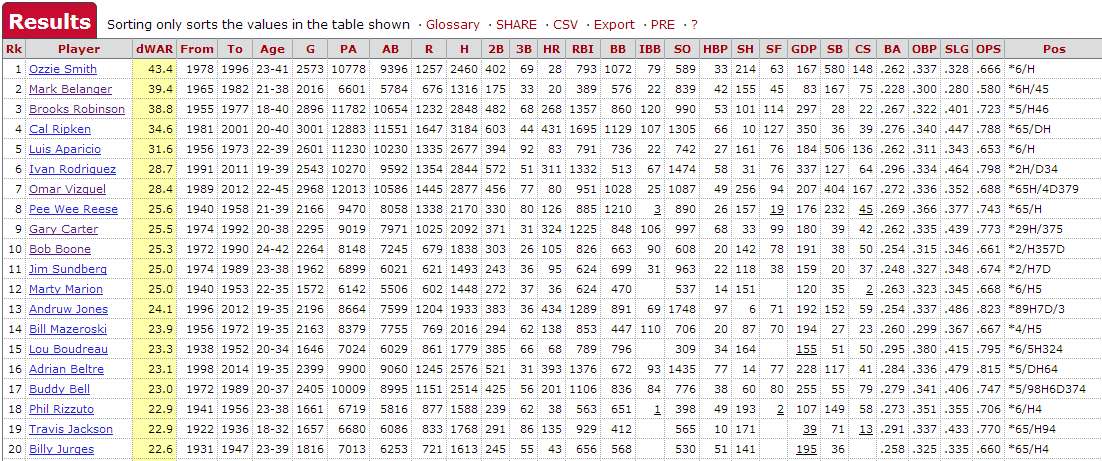 If you look at this list, you will see that Brooks Robinson, Belanger's teammate, ends up one slot below Belanger. And again, Ozzie Smith is the only player to have a higher career dWAR than Belanger. But compare the dWAR of these players to the number of games played. Ozzie Smith's dWAR is a full 4 points higher than Belanger's. But Smith also played in 557 more games. That's nearly three and a half more years. So, to figure out which player truly had the biggest defensive impact from this list, I took the career games played total for each player, and divided by 162. The total seasonADJ figure tells me how many standardized 162 game seasons each player completed in his career. I took their career dWAR figures and divided by the number of standardized 162 game seasons. Mark Belanger is not only the best on this list, he is #1 by a comfortable amount. He averaged nearly a half dWAR more per season than Smith.  When you look at these figures, it's no surprise at all that the Baltimore Orioles were consistently among the elite teams in baseball in the late 60s and early to mid 70s. If you look at the number of Gold Gloves Oriole infielders won between 1969 and 1975, their success isn't surprising. Brooks Robinson 7 at third base Mark Belanger 5 at shortstop Davey Johnson 3 at second base Bobby Grich 3 at second base Baltimore Oriole players won 18 of a possible 21 Gold Gloves at the 3 double play positions. Of course, Brooks Robinson won 9 other Gold Gloves. Before they had Mark Belanger, the Orioles had Luis Aparicio at shortstop, and he won two Gold Gloves for the Orioles, in 1964 and 1967. The Orioles easily had one of the best defensive infields in baseball history. We can look at other metrics that show how great Belanger was. Total Zone Runs, for one, indicates how many runs above or below average a defensive player was worth. Belanger's 35 Total Zone Runs in 1975 is listed as the second best total ever for a shortstop. I question the accuracy of the single season leader. Adam Everett is listed as being worth 40 runs above average in 2006. His second best total in any season was 10 runs above average in 2004. He never had more than 6 in any other season. I'm not contending it's wrong, but that possibility exists. But back to Belanger. This means Belanger's defense saved 35 runs more than the average shortstop in 1975. Belanger led the American League in Total Zone Runs eight times, in 1968, 1971, and ever season from 1973 to 1978. His 238 Total Zone Runs career total is second best all-time, 1 behind Ozzie Smith, who we have already established played some 550 more games than Belanger. Clearly, Belanger is the best shortstop in baseball history at saving runs when time played is considered as a factor. Remember, these figures represent above or below average. If I am interpreting this correctly, Mark Belanger, over the course of his career, saved 238 more runs than an average shortstop would have over the same period of time. Per Fangraphs, Total Zone ratings break down into tiers. League average would be zero. Positive scores represent above average fielding, negative scores below average fielding. 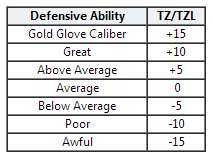 Belanger, clearly, was exceptional, scoring above 15, the Gold Glove threshold, seven times. Still other methods of assessing Belanger's true greatness exist. Range factor being one. Range factor measures a defender's contribution to a team's defense. It calculates putouts and assists per 9 innings. It takes the exact opposite approach to fielding percentage, which calculates how cleanly a fielder handles the balls he makes a play on. Range factor rewards players with range because, theoretically, they will get to more balls than somebody with less range. Range can be derived from different factors-reflexes, instincts, speed, and athleticism. Simply put, if two shortstops are compared, the one with the higher range factor is making a greater contribution towards his team's success by getting to, and making more plays. Mark Belanger's range factor per 9 innings is the 4th best all-time by a shortstop at 5.241. Interestingly, the highest range factor/9 IP by a Hall of Famer is 5.215 by Ozzie Smith, who is fifth all-time. Robin Yount, seventh all-time, has the second highest range factor per 9 innings by a shortstop at 5.132. Baseball Reference's Career Leaders & Records for Range Factor per 9 innings as a shortstop There are yet other ways of measuring Belanger's defensive contributions, some of which require thinking outside of the box. One such method would be to examine the number of twenty game winners the Orioles had during Belanger's career. In order for a starting pitcher to win twenty games in a season, they must, of course, remain healthy. They must have an offense to provide run support for them. But most importantly, a successful pitcher should try to limit the number of base runners they allow, as fewer base runners will invariably lead to fewer runs scored. A great defense behind a pitcher will go a long way towards helping them win 20 or more games. During the time when Belanger and Brooks Robinson paired as full time starters, which was from 1968 to 1975, Robinson won all eight of the Gold Gloves that were awarded. Mark Belanger won 5 of the 8 Gold Gloves, losing out to Luis Aparicio in 1968 and 1970, and Detroit Tiger Ed Brinkman in 1972. During this eight year span, the Orioles were incredibly successful. They won their division 5 times, won the American League pennant in 1969, 1970 and 1971, and won the World Series in 1970. And Baltimore's rise to greatness coincided with Belanger's winning the starting job. In 1967, Belanger played only 69 games. The Orioles were 76-85, and finished 6th in the American League. However, the Orioles were 36-33 that year in the games Belanger played. In 1968, the O's improved to 91-71, 2nd place in the American League. The next three seasons, the Orioles won 109, 108 and 101 games. While Belanger's bat had little to do with their success, there is no doubting that Belanger's presence helped to make the team a winner. And there's little doubt, too, that his exceptional defense helped many of the starting pitchers for Baltimore realize unprecedented success. Of the pitchers to win 20 games at one point or another for Baltimore, Jim Palmer was truly the only star of the bunch. He was the Hall of Famer. But there were a lot of other 20 game winners because the team behind them was exceptional. Here's a breakdown of the Baltimore Oriole 20 game winners between 1968 and 1975. 1968: Dave McNally (22-10) 1969: Mike Cuellar (23-11), Dave McNally (20-7) 1970: Jim Palmer (20-10), Mike Cuellar (24-8), Dave McNally (24-9) 1971: Mike Cuellar (20-9),Pat Dobson (20-8),Jim Palmer (20-9), Dave McNally (21-5) 1972: Jim Palmer (21-10) 1973: Jim Palmer (22-9) 1974: Mike Cuellar (22-10) 1975: Jim Palmer (23-11), Mike Torrez (20-9)\ Mike Cuellar was a very good pitcher. He went 185-130, ending with a .587% lifetime winning percentage, and a 3.14 ERA. He won the 1969 Cy Young Award. Dave McNally went 184-119 for a career .607 winning percentage. He ended with a 3.24 ERA. Pat Dobson ended up with a 122-129 career record, and a 3.54 career ERA. After winning 20 games for the Orioles in 1971, he eventually ended up with the New York Yankees. He won 19 games for New York in 1974. Mike Torrez went 185-160 in his career, a .536 winning percentage. He had a 3.96 career ERA. Jim Palmer went 268-152 in his career, good for a .638 winning percentage. Palmer spun an outstanding 2.86 ERA for his career, on his way to 3 Cy Young Awards and election to the Baseball Hall of Fame. Palmer himself added 4 Gold Gloves to his resume. In total, between 1968 and 1975, the Baltimore Orioles had 15 20 game winners. While it's impossible to know just how many of those games were won because of a play made by any individual defender, the defense the Orioles had was stifling. And Belanger, having a higher dWAR per 162 games played than any other defender in baseball history, with the 4th highest shortstop range factor in baseball history, with the second best total zone rating by a shortstop in baseball history (and only 1 point behind Ozzie Smith, who played 550 + more games), was one of the biggest factors in Baltimore's success. He didn't do much with the bat, though he did contribute occasionally. He hit a home run in the first ever American League Championship series game in 1969. He hit .333 in the 1970 ALCS, helping his team get to and ultimately win the World Series. But it was his glove, his brilliant defensive play that ended one rally after another, that helped his team every single game. Unlike a hitter, who can have a cold streak, a great defender contributes every single game they play. And Belanger, who may be the greatest single defensive player in the game's history, should be enshrined in Cooperstown. Players have been enshrined for their offensive prowess only. It is commonly held that Ted Williams was a below average outfielder. He was constantly distracted, thinking about his next at bat. His Hall of Fame induction was based solely on his offensive acumen. Why then should a player not make it to Cooperstown only because of his defensive abilities? Belanger didn't have slumps in the field. While a hitter might only have one or two hits in a game, a shortstop makes several plays each game. How many double plays did Belanger turn in his career? 1,054. He led the American League in assists three times between 1973 and 1976, and the other season he was second in assists. And even with his incredible range, even when he got to balls that other shortstops simply couldn't get to, he didn't make mistakes. Between 1974 and 1978 he led the American League in fielding percentage three times. In the other seasons he was second or third. Belanger was a black hole at shortstop. Balls were hit in his general direction, and rallies were never heard from again. Cal Ripken Jr, a Hall of Famer himself, credits Belanger with teaching him the nuances of the position. Ripken said that Mark Belanger taught him how to turn the double play.  The Blade sends another hitter to the dugout. When a player can be called the very best ever in Major League history, they deserve to be in the Hall of Fame. He may not have been potent with his bat, but defense is half the game, and Belanger was as good at shortstop as anybody who has ever played the position.
__________________
Building these sets: T206, 1953 Bowman Color, 1975 Topps. Great transactions with: piedmont150, Cardboard Junkie, z28jd, t206blogcom, tinkertoeverstochance, trobba, Texxxx, marcdelpercio, t206hound, zachs, tolstoi, IronHorse 2130, AndyG09, BBT206, jtschantz, lug-nut, leaflover, Abravefan11, mpemulis, btcarfagno, BlueSky, and Frankbmd. Last edited by the 'stache; 09-05-2014 at 02:25 AM. |
|
#3
|
|||
|
|||
|
I agree that Belanger may have been the greatest fielder ever but I never thought of him as a hall of famer. Frankly I had always assumed he hadn't played enough. I didn't realize he played over 2,000 games which considering his awful hitting is a great testament to his defensive ability (as is his overall WAR of 41). I actually have no problem w/him going in the HOF though I'd put his teammate, Bobby Grich, in before him.
__________________
Successful transactions with: Bfrench00, TonyO, Mintacular, Patriots74, Sean1125, Bocabirdman, Rjackson44, KC Doughboy, Kailes2872 |
|
#4
|
|||
|
|||
|
Any thoughts on Lee Smith's chances? Seems like a solid HOF prospect, but I think at this point, unlikely to get in.
|
|
#5
|
||||
|
||||
|
Bill- I always enjoy the depth of your research.
However, I am not completely comfortable with defensive statistics in general and dWAR specifically...since I found Gary Carter so far ahead of Johnny Bench on the career list. Maybe I grossly underrated Carter, but Bench was a pioneer and his career was a watershed moment for the science of catching and even with a shorter career, I cannot get my mind around anyone, other than Ivan (Bench.1) having better career defensive value.
__________________
. "A life is not important except in the impact it has on others lives" - Jackie Robinson If you have a chance to make life better for others and fail to do so, you are wasting your time on this earth.- Roberto Clemente |
|
#6
|
|||
|
|||
|
Amazing Research!
I am with you I have always thought Belanger and Dave Concepcion get no credit, maybe because they played on great teams, maybe because they were defensive oriented. But when it comes to HoF voting apparently I'll never get it. You are either a HoFer or your not the first ballot vs. Non first ballot drives me crazy! |
|
#7
|
||||
|
||||
|
I will be looking at a new player starting tonight, Luis Tiant, followed by Omar Vizquel and Dave Parker. It's time to get this thread a-rollin'!
__________________
Building these sets: T206, 1953 Bowman Color, 1975 Topps. Great transactions with: piedmont150, Cardboard Junkie, z28jd, t206blogcom, tinkertoeverstochance, trobba, Texxxx, marcdelpercio, t206hound, zachs, tolstoi, IronHorse 2130, AndyG09, BBT206, jtschantz, lug-nut, leaflover, Abravefan11, mpemulis, btcarfagno, BlueSky, and Frankbmd. |
|
#8
|
|||
|
|||
|
Maybe slide Dwight Evans in there after the others. I always felt he should have gotten in. And in the era he played 15 more Hr over a 20 year career would have done it. He wouldn't be first ballot, but eventually. His bad luck was the incredibly strong field in 99. Ryan, Brett, Yount, all first ballot, and Fisk on his first almost making it.
Steve B |
|
#9
|
||||
|
||||
|
This is an amazing thread...one of the many great reasons I enjoy Net54 so much.
Personally, I never could understand how Gil Hodges successful career as a player and a manger could not be included in the HOF. Jeff |
|
#10
|
|||
|
|||
|
I agree Hodges should be in the Hall. Ted Simmons, as well. Bobby Grich, Lee Smith too. As for any other names mentioned in previous posts, I don't see it. Tiant, Parker, Vizquel, Minoso, were very good players, certainly not Hall of Famers. Murphy and Allen were excellent players, not HoF's. I appreciate defense ( Belanger ), however, if you are on the field it is expected you can catch a ball and throw it. No matter how much of a defensive wizard the player is, if the ball is not hit to you, you cannot do anything about the play. That is why the player needs to be able to hit. Scoring opportunities begin at the plate, rally's, but if a player can't hit, they become rally killers. So not only does the player make an out, they can hit into a double play causing two outs. Of all the major leaguers to play the game, very few are " overlooked " by the Hall.
__________________
My new found obsession the t206! |
|
#11
|
||||
|
||||
|
Hall of Fame
1988 BBWAA ( 3.7%) I rest my case. This is just plain silly, IMO.
__________________
My avatar is a sketch by my son who is an art school graduate. Some of his sketches and paintings are at https://www.jamesspaethartwork.com/ He is available to do custom drawings in graphite, charcoal and other media. He also sells some of his works as note cards/greeting cards on Etsy under JamesSpaethArt. |
|
#12
|
||||
|
||||
|
You know, let's do Dewey right now while I'm thinking about him. Coincidentally enough, I was looking at Dwight Evans' career numbers just a few nights ago, and I thought he was a player that clearly deserved consideration within our discussion here. I will do Luis Tiant tomorrow night.
__________________
Building these sets: T206, 1953 Bowman Color, 1975 Topps. Great transactions with: piedmont150, Cardboard Junkie, z28jd, t206blogcom, tinkertoeverstochance, trobba, Texxxx, marcdelpercio, t206hound, zachs, tolstoi, IronHorse 2130, AndyG09, BBT206, jtschantz, lug-nut, leaflover, Abravefan11, mpemulis, btcarfagno, BlueSky, and Frankbmd. |
|
#13
|
||||
|
||||
|
Dwight Evans, right fielder
Dwight Michael Evans Boston Red Sox (1972-1990) Baltimore Orioles (1991) 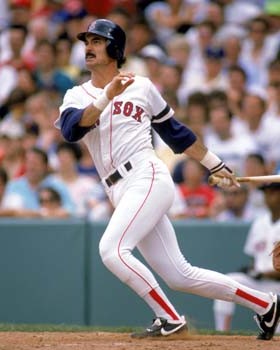  Dwight Evans is one of the stronger candidates from the pool of those players not already in Cooperstown. In fact, when I look at the 3.6% he got the last time he appeared on the ballot, in 1999, I am puzzled. Yes, the competition in 1999 was stiff, as three players were voted in-Nolan Ryan, George Brett and Robin Yount. And six other players on that ballot were eventually voted in by the BBWAA, as well. But surely Evans deserved to remain on the ballot at the very least, didn't he? How does a player with his credentials fail to garner the 5% required to remain on the ballot for future consideration? Dwight's career numbers are listed above. They are impressive, especially when you consider the era he played in. So why was there so little support for one of Boston's favorite players? Before we continue, a few things should be said. One, the advanced metrics used by today's statisticians were not available to the Baseball Writers in 1999. When considering why Dwight Evans fell off the ballot, we would need to consider his worthiness using the same evaluation methods the writers did some fifteen years ago. But to do so would simply be rehashing what has already been done. What we are seeking to do here is make a case for his induction based off of things that the writers might not have seen. In order to proceed with this discussion, and accurately determine if Evans is worthy, I should share my methodology. I have alluded to some things in the past, but I have not done a good job of stating in detail how I look at a player. Before I can start considering Dwight Evans' relevance from a historical context, the first thing I do is compare him against his peers. Specifically, I look at a player's primary position during their career, and compare the subject against the others playing that same position at the same time. Dwight Evans played in 2,606 games in his twenty season career. Of those, the vast majority was spent in right field, where he played 2,092 games. Evans played from 1972 to 1991. Now, Evans merits consideration for the Hall based on his career statistics alone. But his candidacy would be strengthened if it could be shown that he was one of the very best at his particular position during his career. We are doing this because we do not know how deep the position was during his career. So, let's consider the right fielders in Evans' day. In order to get a large enough sample of players, I lower the game requirements to 750 games played. This isn't a perfect method, of course. I might be getting the early years of a player's career before they have hit their prime, meaning their numbers comparatively might be lower. I may also be catching the end of a player's career. But, if I raise the games played requirement, then more players will be excluded. So, I compromise. A total of 26 Major Leaguers played at least 750 games in right field during Evans' career. How did Evans compare against his peers from an offensive standpoint? The one metric I come back to more than any other is OPS. It is not a perfect measurement, but it is a metric that can easily be understood, and it combines two primary elements of offense-getting on base, and hitting for power. A truly dynamic player will hit for power and get on base at a high rate. A high OPS means that the hitter provides value to an offense in multiple ways. Of those 26 players, Evans ranked 5th in OPS, behind Reggie Smith, Darryl Strawberry, Jack Clark and Reggie Jackson. When you look at some of the players who are listed behind Evans, his numbers look even better. Among them are three Hall of Famers: Dave Winfield, Tony Gwynn and Andre Dawson. 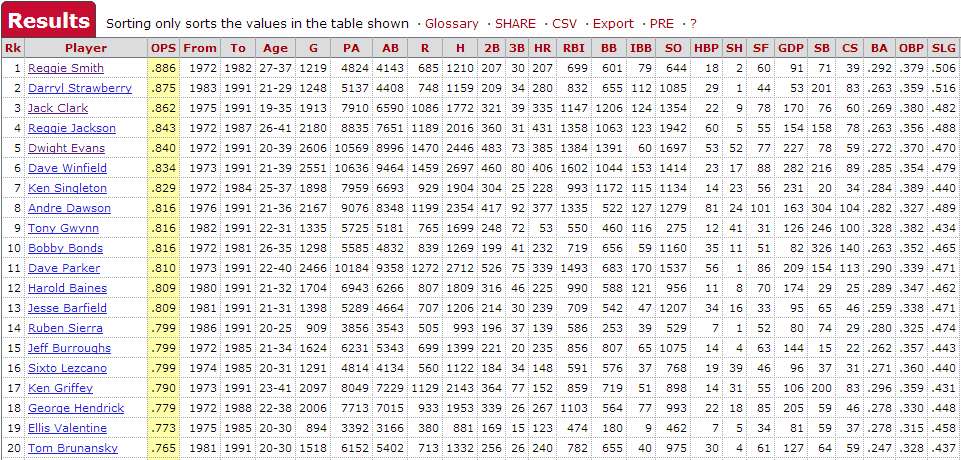 Anytime you beat out hitters of those caliber, you have strengthened your own position. Now, keep in mind, as it has astutely been pointed out to me in the past, OPS does not take several things into consideration, like base stealing, or defense. Dwight Evans was a power hitter, and a run producer. He was not a base stealer by any means. And many of the players on this list provided value to their team by stealing bases. Three stole over 300 bases in their career: Bobby Bonds, Claudell Washington and Andre Dawson. Tony Gwynn stole 246, and early in his career, he was a real base stealing threat, tallying 56 thefts in 1987, and 40 in 1989. Gwynn was also awarded 5 Gold Glove Awards for his defensive play in right field. Andre Dawson won 8 Gold Gloves. But here, too, Dwight Evans provides great value defensively. Evans won 8 Gold Gloves of his own. As Red Sox fans can attest, and as my research showed, Evans had one of the strongest throwing arms in the game. While the number or extra bases he saved with his arm cannot be quantified, it is worth mentioning that his defense was a great asset to the Red Sox, and it elevated his standing among the greats of the game that played during Evans' career. Now, we compare Evans against the very best hitters during his era. This is where Dwight Evans will either shine, or fall short. I mentioned before that Evans was a power hitter. While he only won one home run title in his career, in the strike-shortened 1981 season, hitting 375 home runs in any era is impressive. Again, it is important to consider the era that Evans played in. While Evans was a decent power hitter early in his career, he really found his power stroke as he approached age 30. He hit 22 to lead the American League in '81 as a 29 year old. Between 1982 and 1987, a six year span, he hit 175 home runs, an average of 29 per season, or 31 per 162 games played. In fact, his 162 game average over this 6 year span were outstanding: 111 runs, 34 doubles, 5 triples, 31 home runs and 99 RBI. That's 70 extra base hits per 162 games played for a six year period, all while over 30 years of age. The argument might be made that Evans benefited from playing his home games at Fenway Park. Evans, a right handed hitter, had the Green Monster in left. While it does appear that the Green Monster helped him accumulate more doubles at home (he hit 279 doubles at home, and 204 on the road), his home and road splits are very close when it comes to home runs. Evans hit only 21 more home runs at home than he did on the road (203 vs 182). If anything, it seems that Evans' power was fairly consistent regardless of where he played. Before we compare Evans against the very best hitters from his era, some context is needed. Between the years 1972 and 1991, the entirety of Dwight Evans' career, there were a total of 29 40 home run seasons in the Major Leagues, including only 2 seasons of 50 or more home runs (George Foster's 52 in 1977, and Cecil Fielder's 51 in 1990). Between 1995 and 2014, the last twenty seasons, there have been 158 40 home run seasons, including 25 of 50 or more, 6 of 60 or more, and 2 seasons of 70 or more home runs (Mark McGwire hit 70 in 1998, and Barry Bonds hit 73 in 2001). Baseball Reference.com, 40 home run seasons in the Major Leagues between the years 1972 and 1991. Baseball Reference.com, 40 home run seasons in the Major Leagues between the years 1995 and 2014. Let's now examine the very best hitters from Evans' era. During Evans' career, there were 183 individual seasons where hitters with over 400 at bats reached a .900 OPS. Four of those seasons belonged to Evans, and as previously mentioned, he led the American League twice. Of those one 183 individual seasons, only 17 of them reached a 1.000 or better OPS. Comparatively, there were a whopping 545 individual seasons of .900 or higher OPS between 1995 and 2014, and 138 reached a level of 1.000 or higher. It was a different game when Dwight Evans played. Numbers today are inflated. When Dwight Evans played, getting 385 home runs meant something. Look at it this way. By the time Dwight Evans had retired in 1992, many of the game's all-time greatest power hitters had gone before him. Aaron, Ruth, Mays, Mantle, Robinson, Killebrew. Their spectacular home run totals were etched in the annals of baseball history. But at his retirement, only 29 other men had ever hit more than Dwight Evans' 385 round-trippers. But going back to OPS again, how did he do against his peers. Not only the right fielders, but everybody in the game. Between 1972 and 1991, there were 306 hitters to tally 3,000 or more at bats. Of those, only 20 hitters could top the .840 put up by Dwight Evans. Of those, 9 are Hall of Famers. 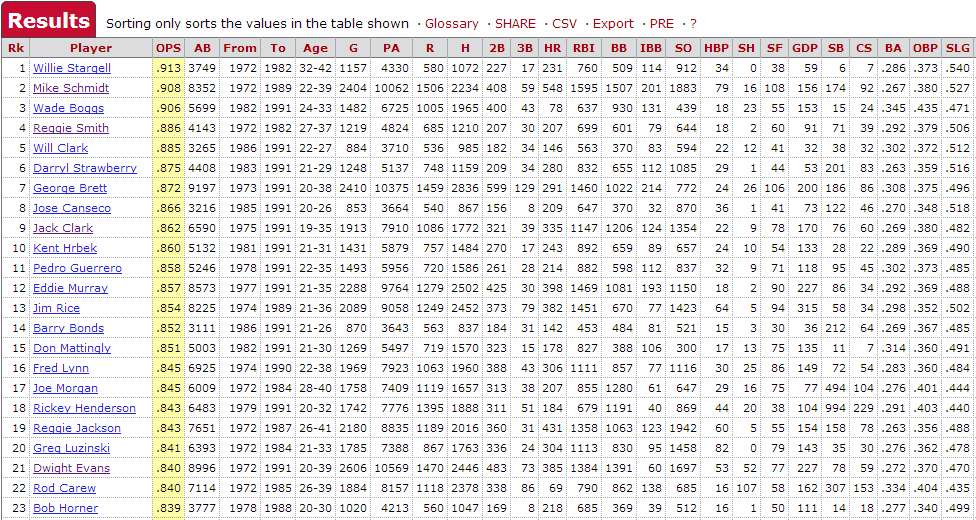 How about comparing Evans against his peers for the decade of the 1980s, which would represent the prime of his career, from age 28 to 37? In the 80s, 140 hitters totaled 3,000 or more at bats. Dwight Evans, from that group, had the sixth best OPS in the Majors. Only Mike Schmidt, Wade Boggs, George Brett, Don Mattingly, and Pedro Guerrero were better in the 80s. He was better than Darryl Strawberry and Eddie Murray, Dale Murphy and Robin Yount. In fact, if you look at the Hall of Famers who played in that decade, he beat 16 of 'em. In fact, if you look at the beginning of the live ball era, 1920, until the end of his career in 1992, his .840 OPS ranks 72nd. The man ahead of him on the list? Carl Yastrzemski at .843. The five men behind him on this list? Greg Luzinski, Don Mattingly, Dave Winfield, Roberto Clemente and Enos Slaughter. Baseball Reference.com list of all-time highest OPS from 1920 to 1992. Evans was top tier offensive force. Was he an elite power hitter? No. The 70s and 80s only truly had two elite power hitters, Mike Schmidt and Reggie Jackson. However, when you combine everything that Evans brought to the table, though, the 941 extra bases, the runs production, his 1,391 walks, he could do everything you'd want a right fielder to do offensively. He had power, and he had a high on base percentage. He wasn't fast, but defensively he made up for his average speed with a tremendously strong and accurate arm. Sounds to me like the prototypical right fielder. Evans had the seventh most home runs in the 70s and 80s. And when you look at the men who had more home runs than him, which of those would you rather have batting fourth or fifth in your lineup? Schmidt and Jackson again, absolutely. Forgetting for just a minute Mike Schmidt's spectacular defensive abilities, he was the home run threat for the entirety of his career. Reggie was comparable, but his OPS was some 63 points lower. The next two men, Darrell Evans and Dave Kingman, brought the home run, and not much else. Kingman managed a paltry 608 walks in nearly 2,000 games. His .302 OBP was just terrible. Evans? Considering his .248 AVG, he had an outstanding OBP of .361, having walked some 1,600 times. Next is Jim Rice, a man who is in the Hall of Fame. I've felt for some time that Evans, not Rice, was the most complete Red Sox outfielder of the trio that started in the 70s (the other being Fred Lynn). My research of the net found this interesting analysis and discussion of just that. A comparison of RAA (runs above average) shows that Evans was not only better, but much better than Rice when all things are considered. Rice was a great hitter, and I am not disputing that. He had a three year run between 1977 and 1979 that would hold up well against many of the game's greatest sluggers. He hit .320 with a .972 OPS across those three seasons, totaling 620 hits, 124 home runs and 384 RBI. He won an MVP (1978), and finished 4th and 5th in the MVP vote the other two seasons. 1983 saw a return to form for Rice, who hit .305 with a .911 OPS, leading the AL with 39 home runs and 126 RBI. He had other very good seasons, too. In 1975, he was second in the Rookie of the Year Vote, and 3rd in the AL MVP (teammate and fellow rookie Fred Lynn won both) hitting .309 with 22 homers and 102 RBI. In 1986, he hit .324 and again topped 200 hits and 100 RBI. But Dwight Evans was a more complete package. He lacked some of the highs Rice achieved (never winning an MVP), but he was steady. And he had that presence in right field. You didn't run on him. But after reading the excellent article written by adarowski back in 2010, when some of the pomp is stripped away, Evans was really better. Of the three outfielders that made up what was arguably the best outfield of the 70s, the Hall of Famer might have been the low man on the totem poll. Rice went to 8 All Star Games. Lynn 9. Evans went to only three. If he were elected, he would tie Robin Yount for fewest All Star Game appearances by a Hall of Famer in the All Star Game era. It seems that Evans did not get the recognition from fans when he played. He was third in the AL MVP race in 1981, that strike shortened season. He finished in the top 5 one other time. Again, under-appreciated could have been Evans' middle name. When everything is considered, I could definitely see Evans as a Hall of Famer. Certainly not on the level of the immortals like Ruth, Aaron or Mays. But a second tier Hall of Famer? Absolutely. Evans has fallen victim to writers who have underappreciated him. History, for example, will remember Carlton Fisk's iconic Game 6 winning home run from the 1975 World Series. But rather unfairly, it seems to forget the spectacular catch and throw double play Dwight Evans made to close the Reds out in the top of the eleventh inning. It seems that the Veteran's Committee owes Dwight Evans some serious consideration. He brought power to an era that power seemed in comparatively short supply. He was great right fielder, collecting 8 Gold Glove Awards. Only 7 other outfielders have ever won more. With this, I will open it up to discussion. Feelings on Dwight Evans belonging in the Hall of Fame?
__________________
Building these sets: T206, 1953 Bowman Color, 1975 Topps. Great transactions with: piedmont150, Cardboard Junkie, z28jd, t206blogcom, tinkertoeverstochance, trobba, Texxxx, marcdelpercio, t206hound, zachs, tolstoi, IronHorse 2130, AndyG09, BBT206, jtschantz, lug-nut, leaflover, Abravefan11, mpemulis, btcarfagno, BlueSky, and Frankbmd. |
|
#14
|
|||
|
|||
|
In theory Pitchers only play defense and bring little to the table hitting wise or dont hit at all anymore....
Andy Petite for HOF.... |
|
#15
|
|||
|
|||
|
Bill, I will agree and disagree with reference to your take on Hernandez. He was a very good first baseman, however, I do not know anyone who would refer to him as elite, as you did.
__________________
My new found obsession the t206! |
|
#16
|
||||
|
||||
|
Quote:
Here's a poll on Baseball Fever that Hernandez wins, taking 44% of the vote" Baseball Fever. Twenty names listed, and he's the top vote getter. And there are references in the discussion to other polls taken in other places, including sabermetric-based sites, where Keith Hernandez won. Just from my own personal discussions with baseball fans, Cardinal and Mets fans I've talked with, he's absolutely revered for his defensive play. His intensity, and his talent, just separated him from the pack. Go to Youtube, and watch the highlight films of him playing. Nothing gets by him. He's diving for balls all over the field. When somebody was dumb enough to bunt against the Mets, Hernandez would come rushing in, grab the ball, and beat the runner going to second with an absolute lightning strike. I watched him play, and he's the best I've ever seen defensively. I got to see him in the '82 World Series with the Cardinals. He did nothing with the bat in the first three or four games. But he was awesome defensively. And then we only had to win one of the last two games to win the series. And Hernandez destroyed us. In the last three games if the series, after going oh for the first four games, he was 7 for 12 with two doubles, a home run and 8 RBI. The guy's a vacuum with a glove.
__________________
Building these sets: T206, 1953 Bowman Color, 1975 Topps. Great transactions with: piedmont150, Cardboard Junkie, z28jd, t206blogcom, tinkertoeverstochance, trobba, Texxxx, marcdelpercio, t206hound, zachs, tolstoi, IronHorse 2130, AndyG09, BBT206, jtschantz, lug-nut, leaflover, Abravefan11, mpemulis, btcarfagno, BlueSky, and Frankbmd. |
|
#17
|
||||
|
||||
|
Luis Tiant, pitcher
Luis Clemente (Vega) Tiant (El Tiante) Cleveland Indians (1964-1969) Minnesota Twins (1970) Boston Red Sox (1971-1978) New York Yankees (1979-1980) Pittsburgh Pirates (1981) California Angels (1982) 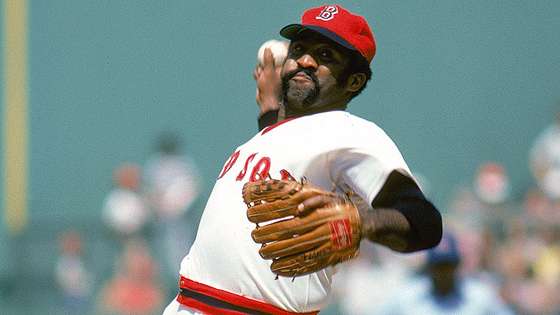  Luis Tiant started his Major League baseball career at an interesting time in baseball history. 1964 marked the beginning of the second "dead ball era", which saw a substantial decrease in runs scored, and hitting, across baseball, but especially in the American League. Some would put the beginning of this era even a year earlier in 1963, which I tend to agree with. 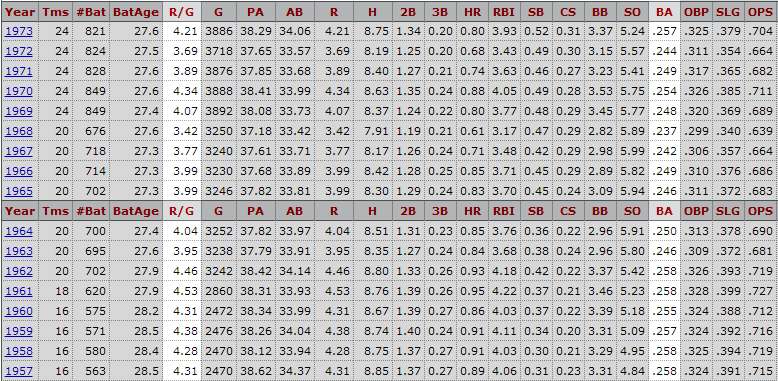 The second dead ball era, and the beginning of Luis Tiant's career Up to the 1962 season, Major League games saw an average of 4.25 runs per game or more, occasionally eclipsing 4.5 runs. In fact, the last time the Major League average dropped to below 4 runs scored per game was in 1943. But in 1963, the Major League average for runs per game dipped to 3.95, and the Major League batting average consistently ranged between .255 and .264 for more than a decade. In 1963, the Major League average dropped to .246. The numbers continued on as well below normal, reaching lows in both runs scored and league batting average in 1968, when there were only 3.42 runs scored per game, and the average Major Leaguer was hitting .237. Why these things happened would make for an interesting discussion in and of itself. But I present this information here to paint a picture of what was going on in baseball at the time Luis Tiant came up to the Majors with the Cleveland Indians. And as you all will soon see, Luis Tiant helped to lower those numbers. And at his very best, Tiant was almost unhittable. But, should Luyis Tiant have been a Hall of Famer, too? Luis Tiant, born in Marianao, La Habana, Cuba in 1940, the only son of Luis Tiant Sr. Tiant Sr was himself a great pitcher for the New York Cubans of the Negro League. Tiant's professional career started in his native Cuba, and upon the recommendation of Bobby Avila, a former All Star infielder for the Cleveland Indians who was scouting for the team in Cuba, Tiant signed with the Mexico City Tigers of the Mexican League. Tiant split his time between the two teams for the next few years, until the Cleveland Indians purchased his contract from the Tigers. Tiant flew to America, and reported to the Charleston Indians, a Class A ball affiliate of the Indians, in 1962. Over the next two years in the minors, Tiant would compile a 29-10 record with an ERA slightly under 2.50. The Majors awaited Tiant. The Indians called him up, and he made his Major League debut in spectacular fashion, throwing a complete game shutout of the New York Yankees at Yankee Stadium on July 19, 1964. He struck out 11 and gave up only 4 hits. His next start was also a complete game, this time at home against the Boston Red Sox. He gave up one run, striking out 6. Tiant was on his way. Luis Tiant, at age 23, would go 10-4 with a 2.83 ERA. He would pitch five more seasons with the Indians, including a spectacular 1968 campaign where he would go 21-9 with an American League leading 1.60 ERA, and 264 strike outs. He allowed 5.3 hits per 9 innings pitched, also best in the league. Yet Tiant, now an All Star, didn't receive a single Cy Young vote, as Denny McClain of the Tigers went 31-6 with a 1.96 ERA. Tiant would go 9-20 the next season as his ERA ballooned up to 3.71. Tiant would spend a single season with the Minnesota Twins, where he would go 7-3, before moving on the the Boston Red Sox. Over the next eight seasons, Tiant and his unique delivery would win 122 games. He would finish in the top 5 of the Cy Young voting twice, and end up sixth another. He'd have three more 20 win seasons, and be named to two more All Star teams. At the end of the 1978 season, Tiant had a career record of 204 wins against 148 losses, and a 3.16 ERA. He would play two seasons with the New York Yankees after signing as a Free Agent, going 21-17 as a Yankee. At age 40, he went to the Pittsburgh Pirates, his first time on a National League team. He started 9 games, and went 2-5. The next season, 1982, he came back to the American League as a member of the California Angels. He made 5 more starts, going 2-2, before calling it a career. At the end of the 1978 season, Tiant had 204 wins and a career 3.16 ERA. A 3.30 ERA, where he ended up at retirement, is still very good. But I think he'd have been better off with the lower ERA as far as his Hall chances go. But, like many of the players we've looked at, Luis Tiant hasn't received serious support from the BBWAA. In 1988, his first season on the ballot, his name appeared on 30.9% of the ballots. One would think that with a decent start like that, he might have a shot at getting closer to the requisite 75%, even if he ultimately felt short. For players to have a reasonably good shot at being voted in by the Veterans Committee, I feel getting a BBWAA vote above 50% is helpful, or at the least, it's indicative of a player's chances down the road. The next year, however, Tiant dropped from 30.9% to 10.5%. Why there was such a precipitous drop is a curiosity to me. In 1988, only Willie Stargell was voted in. Jim Bunning appeared on 74.2% of the ballots, and Tony Oliva was third at 47.3%. Obviously, 1989's ballot brought some tough competition. Carl Yastrzemski and Johnny Bench both made it on their first try, Gaylord Perry received 68.0%, and Bunning received 63.3%. Tiant dropped from 8th to 15th place in the voting. Let's compare Tiant against his contemporaries. What do I compare when looking at pitchers? Obviously, my old standby OPS isn't applicable here. Wins, win-loss record, etc, isn't the greatest indicator of a pitcher's effectiveness. A bad pitcher can still win with enough run support. A great pitcher can still lose with no run support. With pitchers, I like to look at the things they can control first. ERA+ pitchers have a lot of control over, but the defense behind a pitcher also comes into play. ERA + is more effective as it adjusts for the ballparks a pitcher plays his games in. It's a start. So, the first report I ran covered the period of 1964 to 1972. Pitchers who threw a minimum of 1,200 innings across these nine years which are considered the second "dead ball era". Since Tiant's career covered this entire period, and another decade beyond this, running one report over the entire period of his career would skew some of the data. Pitchers who did not throw during this era that favored pitchers (for whatever reason) would suffer comparatively. It would appear that Tiant pitched better than them when he may or may not have. Here are the results of this first report. 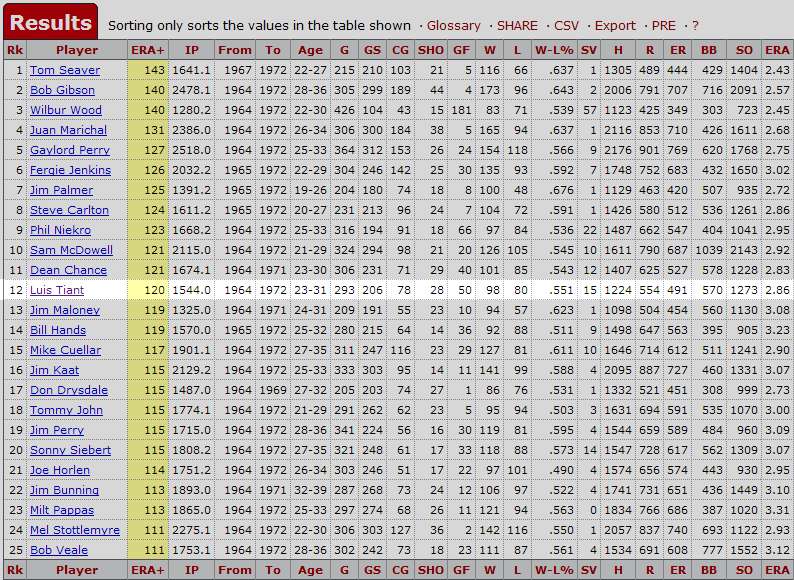 What am I seeing in this report, and other similar reports I have run, changing the years, the inning requirements, etc? Luis Tiant is staying in relatively the same place, in the top 20% of the resulting reports run. In this report, he is 12th out of 61 pitchers who attained 1,200 innings pitched in the Major Leagues between 1964 and 1972. When I open this report up to 1964 to 1982, the entirety of his career, he's 21st in ERA + of 108 pitchers that met the 1,500 innings pitched requirement. You can view the results of the report here if you so choose. What about WHIP, or walks and hits per 9 innings pitched. This is one metric a pitcher has a lot of control over. Again, the defense behind him still impacts the total, but a pitcher can control how many walks he throws, and he can have a big impact on the number of hits he gives up. So, again, 1964 to 1982, 1,500 innings pitched, and Luis Tiant is again 21st on the list. It appears that Mr. Tiant is remarkable consistent. You can read this chart as well, so should you choose. Here's an interesting stat to consider. WPA, or win probability added. This calculates how much of an impact a player had in their team's win. Over the course of a season, or several seasons, or even a career, this is a great sabermetric stat. Plays within a game affect the likelihood that team will win, and WPA will actually weigh the same play differently depending on the situation. A solo home run leading off the game is not weighed the same as a solo home run in the bottom of the ninth in a 2-2 tie. The walk off home run would contribute more to the win. The lead off home run obviously was important. Without it, there would have been no tie. But the game winning home run was definitive. So, when we look at WPA over the course of Tiant's career, we can compare the pitchers that played at the same time, under the same rules, in the same era. Those same 108 pitchers that threw 1,500 innings. Only now Tiant is 10th on the list. Instead of being in the top 20% (19.444% to be precise), he's now closer to 10% (9.259%). Here's the report if you would like to see all the pitchers in order. Notice the pitchers that have lesser WPA scores with approximately the same innings. 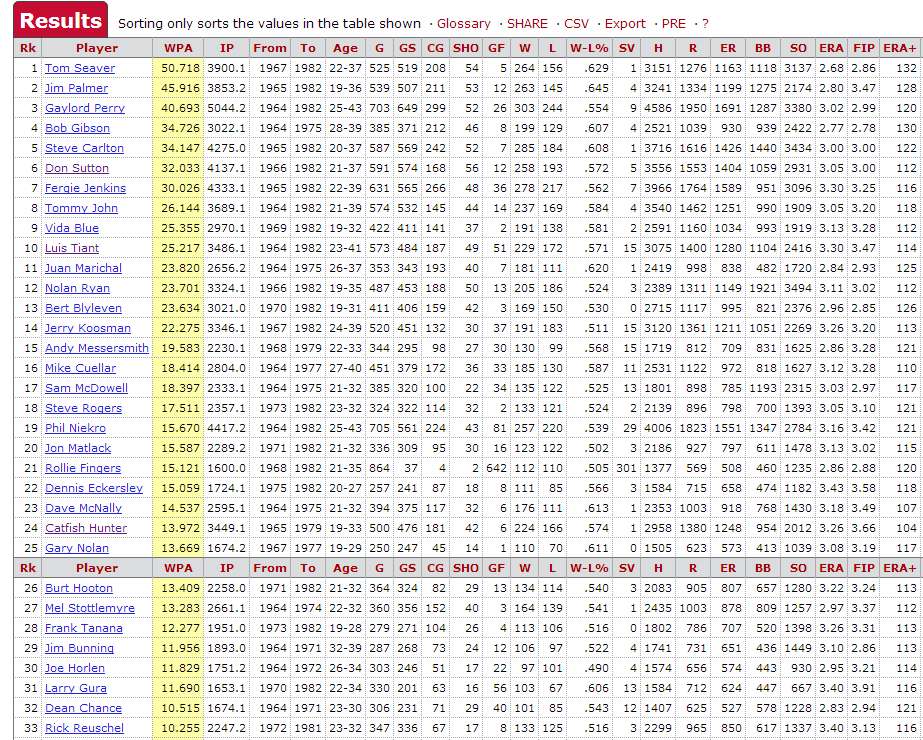 Here's a breakdown I did of Luis Tiant compared to the Hall of Fame pitchers that appeared on this list. This is innings pitched per 1 point of WPA. The math is innings pitched (whole innings only) divided by WPA. A lower number is better. Tom Seaver 76.8957 Jim Palmer 83.9141 Gaylord Perry 123.9574 Bob Gibson 87.0241 Steve Carlton 125.1940 Fergie Jenkins 144.3082 Don Sutton 129.1480 Vida Blue 117.1366 Luis Tiant 138.2400 Juan Marichal 111.5029 Nolan Ryan 140.2472 Bert Blyleven 127.8243 Phil Niekro 281.8761 Dennis Eckersley 114.4830 Rollie Fingers 105.8131 Catfish Hunter 246.8508 Jim Bunning 158.3305 Luis Tiant would be closer to the bottom of the list if they were sorted by total. But he was better than some pretty good pitchers: Catfish Hunter, Nolan Ryan, Phil Niekro, Jim Bunning. Now, I don't know the exact formula of how Win Probability Added is calculated. But it seems to me that this straight forward analysis is sound. Finally, one last metric, also from sabermetrics. Adjusted Pitching Wins (APW), which measures a starting pitcher's value in wins. Between 1964 and 1972, Tiant was ranked 9th in this metric, out of 199 pitchers with 1,000 innings pitched. The eight pitchers ahead of him are all in the Hall of Fame. 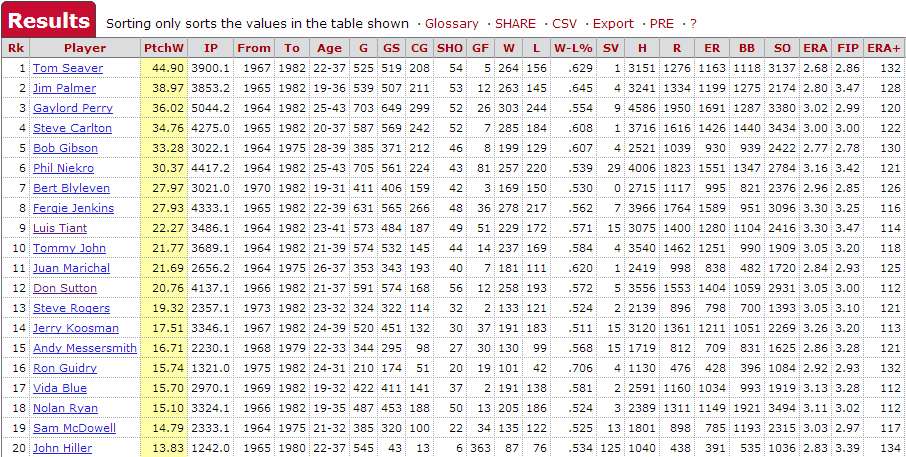 Looking now at awards, accolades, and times he led the league in primary pitching categories. Luis Tiant never won a Cy Young Award, but he certainly had some outstanding seasons, a few which would generally receive serious consideration for the Award. But remember, too, that some of his numbers are skewed somewhat by the era. Pitching ruled for a big part of his career. But, the argument could also be made that the reason pitching ruled was the direct result of the quality pitchers playing the game. No matter how pitcher friendly the second dead ball era might have been, being a starter, and giving up under 2 earned runs a start is special. And Tiant did that twice. Tiant's 1.60 ERA in 1968 was the second best individual season ERA during the period of 1964 to 1982 (minimum 162 innings pitched). And his 1.91 ERA in the 1972 season was the 12th best during this period. Luis Tiant was named to the All Star team only three times (1968, 1974, 1976). He finished in the top 5 for the American League Cy Young twice, and another time, he finished sixth. In 1968, though he did not receive a single Cy Young vote, he finished fifth in the MVP vote. Though he never led the league in wins, he won 22 games once, 21 games twice, and 20 once. In 1975, he won 18. In all, he had 13 seasons of double digit wins. In 1969, his 20 losses led the American League, a year after winning 21 games. He led the league in ERA twice. His 5.3 hits allowed per 9 innings in 1968 led the league, as did his 9.2 strikeouts per 9 innings in 1967. In 1966 and 1968 he led the American League in shutouts. Since the advent of Sabermetrics, Tiant has found himself leading the league in statistics he didn't know existed. In 1968 and 1972, he led the AL in ERA +. He lead the AL in FIP, fielding independent pitching, in 1968, and in WHIP in 1973. What about the Hall of Fame Statistics? The two players most similar to Luis Tiant, Catfish Hunter and Jim Bunning, are both Hall of Famers. The sixth most similar pitcher is another Hall of Famer, Don Drysdale. He falls short in both the black ink and gray ink statistics. His black ink score is 13. A likely Hall of Famer has a 40 black ink score. The average gray ink score for a Hall of Famer is 185. Tiant's is 112. But the two other scores, Tiant is very close to Hall of Fame level. The Hall of Fame Monitor lists a score of 100 as being a likely Hall of Fame inductee. Tiant has a score of 97. And finally, the Hall of Fame Standard has the average Hall of Famer scoring a 50, and Tiant is fairly close with a 41. The Jaffee WAR scoring system (JAWS) ranks Tiant as the 51st best starting pitcher of all-time. Tiant's 66.7 WAR is slightly below the WAR of an average Hall of Fame pitcher, 73.4. Personally, I think Luis Tiant absolutely deserves another look by the Veterans Committee. The clincher for me was the adjusted pitching wins metric. When the only players that had a higher APW over that 19 year period he played were Hall of Famers, he's in pretty rare company. Let's open up the discussion on Luis Tiant. Do pitchers still need to have 300 wins, or 3,000 strikeouts to get in as a starter? Do pitchers from past eras need to get one of these to get into Cooperstown? There are pitchers who, obviously, are exceptions to this. Koufax is one, but Koufax was on a whole other level at the end of his career. Tiant was great in his prime. But was he one of the best pitchers of his era? Would being one of the best be enough? His 162 game averages: 15-11, 3.30 ERA. 155 K, 71 BB in 224 IP. 114 ERA + and a 1.199 WHIP. 7.9 hits, 2.8 walks and 6.2 K per 9 IP. Let's see some Luis Tiant cards, photos, etc, too.
__________________
Building these sets: T206, 1953 Bowman Color, 1975 Topps. Great transactions with: piedmont150, Cardboard Junkie, z28jd, t206blogcom, tinkertoeverstochance, trobba, Texxxx, marcdelpercio, t206hound, zachs, tolstoi, IronHorse 2130, AndyG09, BBT206, jtschantz, lug-nut, leaflover, Abravefan11, mpemulis, btcarfagno, BlueSky, and Frankbmd. |
|
#18
|
||||
|
||||
|
Hmmm. I don't remember Tiant as an 81 Buc. Good stuff, not a HOFer though.
Last edited by Mountaineer1999; 09-16-2014 at 06:37 PM. |
|
#19
|
||||
|
||||
|
Another wonderful job, Bill!
I am more sure that Minoso is a HOFer than Tiant, but, as you said, he deserves strong consideration. While on that island, how about Tony Oliva...I think his injuries cost him any serious consideration, but he would also be close. I also noticed a couple of names high on your Dwight Evans-related tables: Reggie Smith and Jack Clark While I am sure Clark is no candidate, how bad was Smith in the field?
__________________
. "A life is not important except in the impact it has on others lives" - Jackie Robinson If you have a chance to make life better for others and fail to do so, you are wasting your time on this earth.- Roberto Clemente |
|
#20
|
|||
|
|||
|
Quote:
__________________
My new found obsession the t206! |
|
#21
|
||||
|
||||
|
When I was referring to Hernandez as an elite first baseman, I meant his defensive ability was elite only. He was a very good hitter who had some outstanding seasons. But I would never call Hernandez elite offensively, especially for what the majority of first basemen were expected to provide offensively. Hernandez didn't provide enough power to be considered an elite offensive first baseman. But he was so good defensively, I think taken as a whole, he deserves another look for the Hall. I'd rate his defense a 10, and his offense about a 6, a 6.5 or closer to a 7 in his MVP season.
Quote:
__________________
Building these sets: T206, 1953 Bowman Color, 1975 Topps. Great transactions with: piedmont150, Cardboard Junkie, z28jd, t206blogcom, tinkertoeverstochance, trobba, Texxxx, marcdelpercio, t206hound, zachs, tolstoi, IronHorse 2130, AndyG09, BBT206, jtschantz, lug-nut, leaflover, Abravefan11, mpemulis, btcarfagno, BlueSky, and Frankbmd. |
|
#22
|
||||
|
||||
|
Quote:
but WaJo was a better hitter than Belanger.
__________________
FRANK:BUR:KETT - RAUCOUS SPORTS CARD FORUM MEMBER AND MONSTER NUMBER FATHER. GOOD FOR THE HOBBY AND THE FORUM WITH A VAULT IN AN UNDISCLOSED LOCATION FILLED WITH NON-FUNGIBLES 274/1000 Monster Number Nearly*1000* successful B/S/T transactions completed in 2012-24. Over 680 sales with satisfied Board members served. If you want fries with your order, just speak up. Thank you all. Now nearly PQ. |
|
#23
|
||||
|
||||
|
so was...Bob Gibson, Don Drysdale, Wes Ferrell, Catfish Hunter, Don Newcome, Bob Lemon, Warren Spahn...but definitely not Bob Buhl.
__________________
. "A life is not important except in the impact it has on others lives" - Jackie Robinson If you have a chance to make life better for others and fail to do so, you are wasting your time on this earth.- Roberto Clemente |
|
#24
|
||||
|
||||
|
Belanger was the best defensive shortstop I've ever seen, and could have been the greatest to ever play the position. Shouldn't the best of the best be at least considered for the HOF? I know he was a mainstay with the Orioles during the glory years; didn't matter to much what his hitting was he'd be playing short.
Last edited by Mark70Z; 09-15-2014 at 04:32 PM. |
|
#25
|
|||
|
|||
|
doesnt help belanger when ripken jr played as long as him a few years later and considered a better player...
|
|
#26
|
|||
|
|||
|
I think any of us who follow baseball could name 25 shortstops we would rather have on our team than Belanger, and as a bonus we can exclude HoFr's. Begin at 1970. I'm going to bed now.....
__________________
My new found obsession the t206! |
|
#27
|
||||
|
||||
|
Quote:
I've always felt he was good. But I don't know if I've consider him one of the greats defensively. I've felt that Ozzie Smith, Omar Vizquel, Alan Trammell and Barry Larkin were the best defensive shortstops from when I started watching baseball. Gary Templeton was pretty good, too, as was Ozzie Guillen.
__________________
Building these sets: T206, 1953 Bowman Color, 1975 Topps. Great transactions with: piedmont150, Cardboard Junkie, z28jd, t206blogcom, tinkertoeverstochance, trobba, Texxxx, marcdelpercio, t206hound, zachs, tolstoi, IronHorse 2130, AndyG09, BBT206, jtschantz, lug-nut, leaflover, Abravefan11, mpemulis, btcarfagno, BlueSky, and Frankbmd. |
|
#28
|
||||
|
||||
|
Quote:
When I came up with the idea for this thread, it was not my intention to state that any player we would be discussing definitely belonged in the Hall of Fame. It was meant to be a discussion of players that we felt had been overlooked by the BBWAA, and deserved a second look by the Baseball Veterans Committee. Unfortunately, I got a little carried away when I wrote my first post about Belanger. I'd just read a write up about his defensive skills, and the people that were writing about him probably propped him up when it came to writing about Belanger's abilities. It's difficult to know just how he matches up against the others that might be considered the best defensive shortstops to ever play the game, because as great as he may have been, defensive statistics have always lagged behind those for offense. I think it's likely that Belanger is one of the ten best defensive shortstops to play the game. I never saw Belanger, Luis Aparicio, Phil Rizzuto, Bill Dahlen, or Rabbit Maranville play. I have seen Ozzie Smith, Omar Vizquel, Alan Trammell, etc. How do we reconcile these from such different eras?
__________________
Building these sets: T206, 1953 Bowman Color, 1975 Topps. Great transactions with: piedmont150, Cardboard Junkie, z28jd, t206blogcom, tinkertoeverstochance, trobba, Texxxx, marcdelpercio, t206hound, zachs, tolstoi, IronHorse 2130, AndyG09, BBT206, jtschantz, lug-nut, leaflover, Abravefan11, mpemulis, btcarfagno, BlueSky, and Frankbmd. |
|
#29
|
||||
|
||||
|
Quote:
Now, while I was growing up I loved the defensive perspective of the game. It may be due to Brooksie being my hero growing up. Anyway, I saw Belanger and Ripken play and, in my view, Belanger was better defensively and of course Ripken was far better offensively. I've seen the modern shortstops play, like I said, I focused on that part of the game and defensively give me "The Blade" before any of those Ozzie, Omar, Trammell, etc. (even though they were exceptional shortstops). Last edited by Mark70Z; 09-16-2014 at 05:15 PM. |
 |
|
|
 Similar Threads
Similar Threads
|
||||
| Thread | Thread Starter | Forum | Replies | Last Post |
| Evidence of trimming? | bobbvc | Net54baseball Vintage (WWII & Older) Baseball Cards & New Member Introductions | 7 | 04-05-2014 09:44 PM |
| Cooperstown victim of Cooperstown Forger! New article | okmaybent@aol.com | Net54baseball Vintage (WWII & Older) Baseball Cards & New Member Introductions | 0 | 05-17-2012 03:11 PM |
| SABR "2010 Overlooked 19C BB Legend" Vote Results | Joe_G. | Net54baseball Vintage (WWII & Older) Baseball Cards & New Member Introductions | 21 | 08-15-2010 02:19 PM |
| Have you seen the 1890 NY Players League team photo this drawing is based on? | orator1 | Net54baseball Vintage (WWII & Older) Baseball Cards & New Member Introductions | 4 | 07-01-2009 11:41 AM |
| The Evidence as Promised | Archive | Net54baseball Vintage (WWII & Older) Baseball Cards & New Member Introductions | 7 | 05-01-2008 07:02 PM |